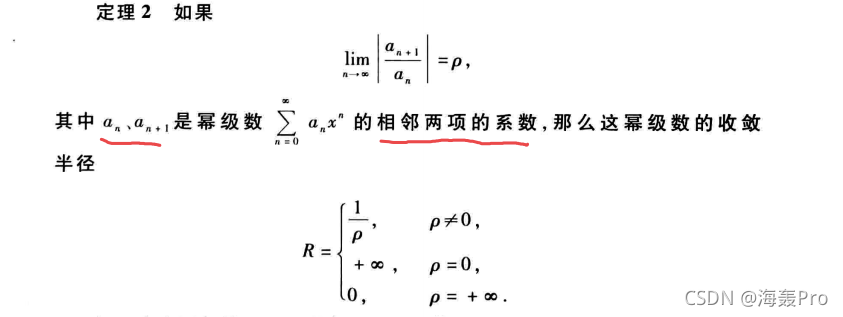【机器学习|数学基础】Mathematics for Machine Learning系列之矩阵理论(25):幂级数(补充知识)

前言
Hello!小伙伴!
非常感谢您阅读海轰的文章,倘若文中有错误的地方,欢迎您指出~
自我介绍 ଘ(੭ˊᵕˋ)੭
昵称:海轰
标签:程序猿|C++选手|学生
简介:因C语言结识编程,随后转入计算机专业,有幸拿过一些国奖、省奖…已保研。目前正在学习C++/Linux/Python
学习经验:扎实基础 + 多做笔记 + 多敲代码 + 多思考 + 学好英语!
机器学习小白阶段
文章仅作为自己的学习笔记 用于知识体系建立以及复习
知其然 知其所以然!
往期文章
【机器学习|数学基础】Mathematics for Machine Learning系列之矩阵理论(1):集合与映射
【机器学习|数学基础】Mathematics for Machine Learning系列之矩阵理论(2):线性空间定义及其性质
【机器学习|数学基础】Mathematics for Machine Learning系列之矩阵理论(3):线性空间的基与坐标
【机器学习|数学基础】Mathematics for Machine Learning系列之矩阵理论(4):基变换与坐标变换
【机器学习|数学基础】Mathematics for Machine Learning系列之矩阵理论(5):线性子空间
【机器学习|数学基础】Mathematics for Machine Learning系列之矩阵理论(6):子空间的交与和
【机器学习|数学基础】Mathematics for Machine Learning系列之矩阵理论(7):欧氏空间
【机器学习|数学基础】Mathematics for Machine Learning系列之矩阵理论(8):标准正交基与Gram-Schmidt过程
【机器学习|数学基础】Mathematics for Machine Learning系列之矩阵理论(9):正交补与投影定理
【机器学习|数学基础】Mathematics for Machine Learning系列之矩阵理论(10):线性变换定义
【机器学习|数学基础】Mathematics for Machine Learning系列之矩阵理论(11):线性变换的矩阵表示
【机器学习|数学基础】Mathematics for Machine Learning系列之矩阵理论(12):相似形理论
【机器学习|数学基础】Mathematics for Machine Learning系列之矩阵理论(13):Hamliton-Cayley定理、最小多项式
【机器学习|数学基础】Mathematics for Machine Learning系列之矩阵理论(14):向量范数及其性质
【机器学习|数学基础】Mathematics for Machine Learning系列之矩阵理论(15):矩阵的范数
【机器学习|数学基础】Mathematics for Machine Learning系列之矩阵理论(16):向量和矩阵的极限
【机器学习|数学基础】Mathematics for Machine Learning系列之矩阵理论(17):函数矩阵的微分和积分
【机器学习|数学基础】Mathematics for Machine Learning系列之矩阵理论(18):方阵的幂级数
【机器学习|数学基础】Mathematics for Machine Learning系列之矩阵理论(19):不定积分(补充知识)
【机器学习|数学基础】Mathematics for Machine Learning系列之矩阵理论(20):方阵函数
【机器学习|数学基础】Mathematics for Machine Learning系列之矩阵理论(21):常用方阵函数的一些性质
【机器学习|数学基础】Mathematics for Machine Learning系列之矩阵理论(22):方阵函数在微分方程组中的应用
【机器学习|数学基础】Mathematics for Machine Learning系列之矩阵理论(23):常数项级数的概念和性质(补充知识)
【机器学习|数学基础】Mathematics for Machine Learning系列之矩阵理论(24):常数项级数的审敛法(补充知识))
幂级数
一、函数项级数的概念
定义:(函数项)无穷级数
如果给定一个定义在区间 I I I上的函数列
u 1 ( x ) , u 2 ( x ) , u 3 ( x ) , . . . , u n ( x ) , . . . , u_1(x),u_2(x),u_3(x),...,u_n(x),..., u1(x),u2(x),u3(x),...,un(x),...,
那么由这函数列所构成的表达式
u 1 ( x ) + u 2 ( x ) + u 3 ( x ) + . . . + u n ( x ) + . . . u_1(x) + u_2(x) + u_3(x) + ... + u_n(x) + ... u1(x)+u2(x)+u3(x)+...+un(x)+...
称为定义在区间 I I I上的(函数项)无穷级数,简称(函数项)级数
对于每一个确定的值 x 0 ∈ I x_0\in I x0∈I,函数项级数成为常数项级数
u 1 ( x 0 ) + u 2 ( x 0 ) + u 3 ( x 0 ) + . . . + u n ( x 0 ) + . . . u_1(x_0) + u_2(x_0) + u_3(x_0) + ... + u_n(x_0) + ... u1(x0)+u2(x0)+u3(x0)+...+un(x0)+...
这个级数可能收敛,也可能发散
如果这个级数收敛,就称点 x 0 x_0 x0是函数项级数的收敛点
如果这个级数发散,就称点 x 0 x_0 x0是函数项级数的发散点
函数项级数的收敛点的全体称为它的收敛域,发散点的全体称为它的发散域
幂级数及其收敛性
幂级数
各项都是常数乘以幂函数的函数项级数,即为幂级数,形式为
∑ n = 0 ∞ a n x n = a 0 + a 1 x + a 2 x 2 + . . . + a n x n + . . . . \sum_{n=0}^{\infty}a_n x^n=a_0 + a_1 x + a_2 x^2 + ... + a_n x^n + .... n=0∑∞anxn=a0+a1x+a2x2+...+anxn+....
其中常数 a 0 , a 1 , a 2 , . . . , a n , . . . a_0,a_1,a_2,...,a_n,... a0,a1,a2,...,an,...叫做幂级数的系数
定理1(阿贝尔定理)

推论

定理2

结语
说明:
- 参考于 课本《高等数学》
- 配合书中概念讲解 结合了自己的一些理解及思考
文章仅作为学习笔记,记录从0到1的一个过程
希望对您有一点点帮助,如有错误欢迎小伙伴指正

文章来源: haihong.blog.csdn.net,作者:海轰Pro,版权归原作者所有,如需转载,请联系作者。
原文链接:haihong.blog.csdn.net/article/details/121323497
- 点赞
- 收藏
- 关注作者


评论(0)